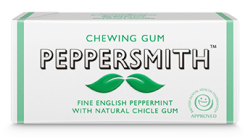10 tips for fresh breath
Timely advice from Sarah Stacey as the mistletoe season approaches... 1 Brush your teeth twice a day.
2 Make interdental brushing part of your daily routine. We like TePe Interdental Brushes/£3 for six, from Boots. Tips at www.tepe.com/uk.
3 Use a tongue scraper, such as TePe Tongue Cleaner/£2.49, www.chemistdirect.co.uk.
 4 Rinse daily with a good mouthwash such as UltraDex Daily Oral Rinse/£8.20, www.boots.com.
4 Rinse daily with a good mouthwash such as UltraDex Daily Oral Rinse/£8.20, www.boots.com.
5 Keep hydrated by sipping water all day. Rinse your mouth with water after you eat.
6 Avoid eating foods such as onion and garlic before a special occasion.
7 Don’t smoke.
 8 Chew sugar- and aspartame-free gum after a meal instead of mints. Try Peppersmith Fine English Peppermint Chewing Gum, which is made with xylitol/£1.49, www.hollandandbarrett.com.
8 Chew sugar- and aspartame-free gum after a meal instead of mints. Try Peppersmith Fine English Peppermint Chewing Gum, which is made with xylitol/£1.49, www.hollandandbarrett.com.
9 Make regular appointments with your dental hygienist.
10 If you still have bad breath, consult your doctor as it may be related to a medical condition.
Q. My six-year-old son has been diagnosed with glue ear. Our doctor says we should wait for three months to see if it clears up before considering treatment. Is there anything we can do in the meantime?
A. Glue ear – when the middle ear becomes filled with fluid – causes varying degrees of hearing loss and earache, which may mean children do less well at school, sleep poorly and sometimes need pain relief.
‘Why fluid builds up is unclear,’ says Dr. Rob Hicks (www.drrobhicks.co.uk), ‘but it’s thought to be related to a problem with the eustachian tube, which connects the middle ear with the back of the throat.’ It is often associated with viral infection.
Glue ear is common, affecting about eight in 10 children at least once by the time they are ten years old. Many cases do clear on their own within three months, which is why your doctor suggests waiting. Surgery to insert grommets in the ear may eventually be necessary for some children.
However, new research by the University of Southampton has shown that a noninvasive treatment called balloon autoinflation can help relieve symptoms during the three-month period of ‘active monitoring’.
All available pharmaceutical treatments (antibiotics, antihistamines, decongestants and intranasal steroids) are ineffective and have side effects, according to the researchers.
‘The treatment simply involves a child blowing up a special balloon with his nose a few times a day. It helps by opening up the eustachian tube, making it easier for fluid to drain from the middle ear,’ explains Dr Hicks. (It is rather like blowing through your nose to clear your ears when you fly.)
In the study, 320 children with glue ear, aged four to 11, were divided into two groups – one using the Otovent auto inflation balloon (www.gluear.co.uk), the other not. After a month, 47 per cent of children in the Otovent group were clear of glue ear compared with 36 per cent in the control group.
After three months of treatment, half the children who used the balloon were free of the condition compared to 38 per cent in the group that didn’t.
‘It seems to be a very good method for improving symptoms and quality of life while reducing harmful treatments,’ says lead researcher Dr. Ian Williamson. Otovent may help a child get better more quickly and also avoid surgery. It’s vital to stick to the regime for it to have a chance of helping, though.
The balloon method is available on the NHS and can be prescribed by your doctor.
 Fitness expert Louise Parker recommends investing in KO 8, a new piece of equipment that combines suspension training with resistance bands. (Suspension training involves adjustable straps that fix to an anchor point, so you can harness your body weight against gravity and do exercises while suspended.) ‘KO 8 allows people to perform moves that challenge every muscle,’ says Louise. ‘It’s simple and fun.’ Our testers agreed and especially liked the online support. £118, www.ko8.co.uk. Claim a 15 per cent discount until 31 December with the code YOU 15.
Fitness expert Louise Parker recommends investing in KO 8, a new piece of equipment that combines suspension training with resistance bands. (Suspension training involves adjustable straps that fix to an anchor point, so you can harness your body weight against gravity and do exercises while suspended.) ‘KO 8 allows people to perform moves that challenge every muscle,’ says Louise. ‘It’s simple and fun.’ Our testers agreed and especially liked the online support. £118, www.ko8.co.uk. Claim a 15 per cent discount until 31 December with the code YOU 15.

